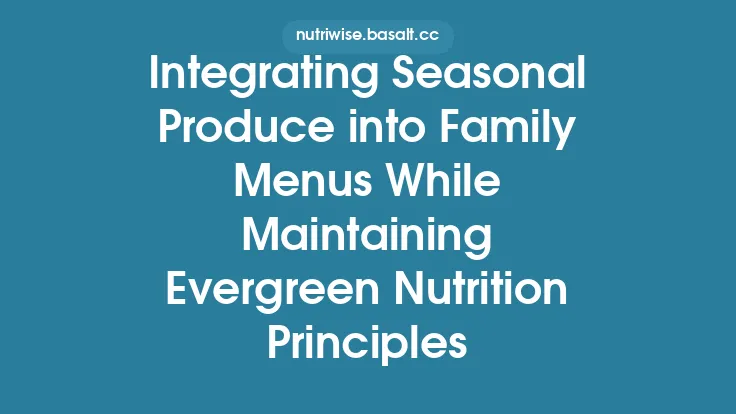Seasonal recipe rotation is more than a clever culinary gimmick; it is a strategic approach to meal planning that safeguards nutritional adequacy, sustains palate interest, and aligns eating patterns with the body’s fluctuating physiological demands throughout the year. By deliberately cycling recipes in concert with the calendar, home cooks can avoid the monotony that often accompanies static meal plans, mitigate the risk of micronutrient shortfalls, and create a resilient food system that adapts to seasonal shifts in availability, cost, and cultural context. The following guide outlines an evergreen framework for constructing, executing, and refining a year‑long rotation that balances variety, nutrition, and practicality.
Understanding the Rationale Behind Seasonal Rotation
Physiological Seasonality
Human metabolism is subtly attuned to environmental cues such as daylight length, temperature, and humidity. Research in chronobiology indicates that hormone levels (e.g., melatonin, cortisol) and immune function fluctuate across the year, influencing energy expenditure, appetite, and nutrient utilization. A rotating menu that mirrors these cycles can provide targeted support—for instance, emphasizing hydrating foods and electrolytes during hotter months, or focusing on thermogenic, nutrient‑dense meals when ambient temperatures drop.
Nutrient Density Over Time
While any single recipe can be nutritionally complete, relying on a narrow set of dishes increases the probability of chronic deficiencies (e.g., low vitamin D in winter, insufficient folate in early spring). A systematic rotation ensures that the cumulative intake of essential vitamins, minerals, and phytonutrients meets or exceeds the Dietary Reference Intakes (DRIs) across the twelve months.
Culinary Fatigue Prevention
Repeated exposure to the same flavor profiles can diminish enjoyment and reduce adherence to a meal plan. Rotational variety stimulates the gustatory system, encouraging sustained engagement and reducing the temptation to resort to convenience foods.
Building a Year‑Long Recipe Framework
- Segment the Calendar
Divide the year into logical blocks—typically four quarters or twelve monthly segments. Each block serves as a “rotation window” during which a core set of recipes will be featured.
- Assign Core Recipe Categories
For each window, select a balanced mix of:
- Protein‑centric dishes (legume stews, poultry roasts, fish preparations)
- Complex‑carbohydrate plates (whole‑grain pilafs, tuber‑based casseroles)
- Vegetable‑forward sides (roasted medleys, sautéed greens)
- One‑pot or batch‑cook options (soups, chilies, casseroles) for efficiency
Aim for 8–12 anchor recipes per window, providing enough variety for weekly rotation while keeping the list manageable.
- Map Overlap Zones
Design transitional recipes that can bridge two adjacent windows. These “crossover” dishes contain ingredients that are still reasonably available at the tail end of one season and the start of the next, smoothing the shift without abrupt changes.
- Incorporate Seasonal “Boosters”
Add optional add‑ons (e.g., a garnish of fresh herbs, a drizzle of citrus‑based vinaigrette) that can be swapped in when the corresponding fresh produce is at its peak. This preserves the core recipe’s integrity while allowing for seasonal flair.
Integrating Nutritional Goals Across Seasons
Macro‑Distribution Planning
Establish baseline macronutrient targets (e.g., 45–55 % carbohydrate, 20–30 % protein, 25–35 % fat) that remain constant throughout the year. Within each rotation window, adjust the proportion of each macronutrient to reflect seasonal energy demands:
- Warmer months: Slightly higher carbohydrate intake to support increased physical activity and glycogen replenishment.
- Colder months: Modest elevation of healthy fats to aid thermogenesis and satiety.
Micronutrient Coverage Matrix
Create a spreadsheet that lists key micronutrients (vitamin A, C, D, E, B‑complex, calcium, iron, magnesium, zinc) across the twelve months. For each anchor recipe, assign a qualitative rating (high, moderate, low) for each nutrient. Use conditional formatting to highlight months where a particular nutrient falls below the recommended threshold, prompting the inclusion of supplemental “boosters” or alternative recipes.
Bioavailability Considerations
Seasonal physiological changes can affect nutrient absorption. For example, vitamin D synthesis from sunlight declines in winter, necessitating dietary compensation through fortified foods or oily fish. Similarly, the gut microbiome’s composition shifts with temperature, influencing the conversion of plant‑based compounds (e.g., carotenoids) into active forms. Incorporate recipes that contain absorption enhancers (e.g., dietary fats for fat‑soluble vitamins) in the relevant windows.
Designing Rotational Themes and Culinary Cycles
Cultural and Regional Themes
Assign each rotation window a culinary theme that aligns with traditional seasonal eating patterns (e.g., Mediterranean summer, Nordic winter). This approach not only diversifies flavor but also leverages time‑tested combinations that naturally address seasonal nutritional needs.
Cooking‑Method Cycles
Vary primary cooking techniques across the rotation to broaden nutrient retention and texture profiles:
- Grilling/Barbecuing (summer) – enhances Maillard reactions, adds smoky flavor.
- Stewing/Braising (autumn) – preserves moisture, concentrates nutrients.
- Fermentation/Pickling (winter) – introduces probiotic benefits.
- Raw/Minimal‑Heat Preparations (spring) – maximizes heat‑sensitive vitamin retention.
Ingredient‑Focus Rotations
Within each window, rotate the dominant ingredient class (legumes, whole grains, nuts/seeds, seafood). This systematic shift ensures that protein sources, fiber types, and fatty acid profiles are evenly distributed over the year.
Leveraging Preserved and Shelf‑Stable Ingredients
When fresh produce is out of season or cost‑prohibitive, preserved forms can sustain nutritional continuity without compromising the rotation’s integrity.
- Free‑Frozen Produce: Freezing within hours of harvest locks in most vitamins (especially A, C, and B‑complex) and phytonutrients. Incorporate frozen berries, peas, or spinach into smoothies, sauces, and stir‑fries as direct substitutes for fresh counterparts.
- Canned Legumes and Fish: Properly processed canned beans and fish retain protein quality and essential minerals. Rinse canned beans to reduce sodium, and select low‑oil fish varieties to manage fat intake.
- Dried Herbs and Spices: Concentrated sources of antioxidants and anti‑inflammatory compounds. Use them strategically to replicate seasonal flavor profiles when fresh herbs are unavailable.
- Shelf‑Stable Whole Grains: Brown rice, quinoa, barley, and farro store well and provide consistent carbohydrate and fiber sources throughout the year.
By integrating these items into the rotation, you maintain variety and nutrient density while mitigating the impact of seasonal market fluctuations.
Monitoring Nutrient Gaps and Adjusting the Cycle
Periodic Nutrient Audits
Every quarter, conduct a brief audit using a nutrition tracking app or spreadsheet. Compare actual intake (derived from meal logs) against the target values established in the micronutrient matrix. Identify any recurring shortfalls.
Adaptive Recipe Substitution
If a particular nutrient consistently falls below target, replace or augment a low‑scoring recipe with an alternative that offers higher levels of that nutrient. For instance, if iron intake dips during late winter, introduce a lentil‑based stew or a fortified cereal dish into the rotation.
Supplementation Strategy
When dietary adjustments are insufficient or impractical, consider targeted supplementation (e.g., vitamin D during months with limited sunlight). Document any supplements used alongside the rotation plan to maintain a holistic view of nutrient intake.
Incorporating Cultural and Regional Influences
Seasonal eating is deeply rooted in cultural heritage. Embedding regional traditions into the rotation enriches the experience and often aligns with seasonal health needs.
- Festive Foods: Align certain recipes with cultural holidays that naturally occur in specific seasons (e.g., harvest festivals, solstice celebrations). These dishes typically incorporate seasonally appropriate ingredients and can serve as anchor meals.
- Local Food Calendars: Consult regional agricultural extensions or community-supported agriculture (CSA) calendars to identify historically seasonal foods. Even if you are not sourcing directly from local farms, acknowledging these cycles can guide recipe selection.
- Traditional Preservation Techniques: Incorporate methods such as pickling, smoking, or drying that have been used historically to extend the availability of seasonal foods. These techniques add depth to the rotation while honoring culinary heritage.
Practical Tools for Managing a Seasonal Rotation
| Tool | Primary Function | How It Supports Rotation |
|---|---|---|
| Digital Calendar (Google Calendar, Outlook) | Schedule recipe weeks and thematic blocks | Set recurring events for each rotation window; attach recipe links and grocery lists |
| Meal‑Planning Software (e.g., Paprika, Mealime) | Store recipes, generate shopping lists | Tag recipes by season, theme, and nutrient profile; auto‑populate weekly plans |
| Spreadsheet (Excel, Google Sheets) | Track nutrient matrices, ingredient inventories | Use formulas to flag nutrient gaps; maintain a rolling inventory of pantry staples |
| Barcode Scanning Apps (MyFitnessPal, Cronometer) | Log actual food intake | Verify that the executed meals align with the planned nutrient targets |
| Label‑Making Tools (Avery Design & Print) | Organize pantry and freezer | Clearly mark preserved items with “Seasonal Use” tags to streamline recipe selection |
Implementing a combination of these tools reduces cognitive load, ensures consistency, and provides data for continuous improvement.
Evaluating Success and Making Iterative Improvements
- Quantitative Metrics
- Nutrient Adequacy Ratio (NAR): Average percentage of DRIs met across all nutrients per month. Aim for NAR ≥ 90 % consistently.
- Recipe Diversity Index (RDI): Number of unique anchor recipes used per quarter divided by total possible recipes. Higher RDI indicates greater variety.
- Qualitative Feedback
- Conduct brief surveys with household members regarding satisfaction, perceived energy levels, and culinary enjoyment.
- Record observations about seasonal health markers (e.g., frequency of colds, digestive comfort) to correlate with rotation phases.
- Adjustment Cycle
- Quarterly Review: Analyze metrics, identify underperforming recipes, and replace them with alternatives that address identified gaps.
- Annual Refresh: At the end of the year, evaluate the entire rotation, retire recipes that no longer resonate, and introduce new ones to keep the system dynamic.
Frequently Asked Questions About Seasonal Recipe Rotation
Q: Do I need to completely overhaul my pantry each season?
A: No. The rotation relies on a core set of shelf‑stable staples that persist year‑round. Seasonal changes are introduced through fresh or preserved items that complement the existing base.
Q: How can I accommodate dietary restrictions (e.g., gluten‑free, vegan) within the rotation?
A: Tag each recipe with relevant dietary attributes in your planning software. Ensure that each seasonal block contains at least one compliant option for each restriction, and use substitution lists (e.g., quinoa for wheat, tempeh for meat) to maintain nutritional balance.
Q: Is it necessary to track micronutrients manually?
A: While manual tracking provides the most precision, many nutrition apps can automate the process if you log meals consistently. Even a simple quarterly audit using a spreadsheet can reveal trends without daily logging.
Q: What if I travel during a particular season?
A: Build flexibility into the rotation by designating “travel‑friendly” recipes—those that rely on pantry items, require minimal cooking, or can be prepared in advance and reheated.
Q: Can I incorporate leftovers without disrupting the rotation?
A: Absolutely. Leftovers can be repurposed as “boosters” or incorporated into the next week’s menu, provided they align with the seasonal theme and nutrient goals.
By establishing a structured, data‑informed, and culturally resonant seasonal recipe rotation, you create a sustainable culinary ecosystem that delivers continuous variety, meets comprehensive nutritional needs, and adapts gracefully to the rhythms of the year. The result is not only a healthier body but also a more engaged and joyful relationship with food.





